Analyzing Google’s Organizational Structure and Culture: A Case Study
VerifiedAdded on 2019/09/20
|6
|2338
|496
Case Study
AI Summary
This case study delves into Google's organizational structure and culture, highlighting how they synergistically support the company's innovation and competitive strength. It examines Google's cross-functional, flat matrix structure, emphasizing its function-based and product-based definitions. The study also explores Google's open, innovative, and hands-on culture, which fosters employee involvement and the free exchange of ideas. The analysis covers Google's leadership structure, the 70/20/10 rule, and how the company has adapted its management practices over time. The case study also touches upon criticisms, Google's motto, and the company's evolution, including its experiments and its ability to learn from mistakes while maintaining a long-term vision. The study shows how Google's organizational structure and culture are designed to encourage both loyalty and creativity, leading to the development of significant products and services.
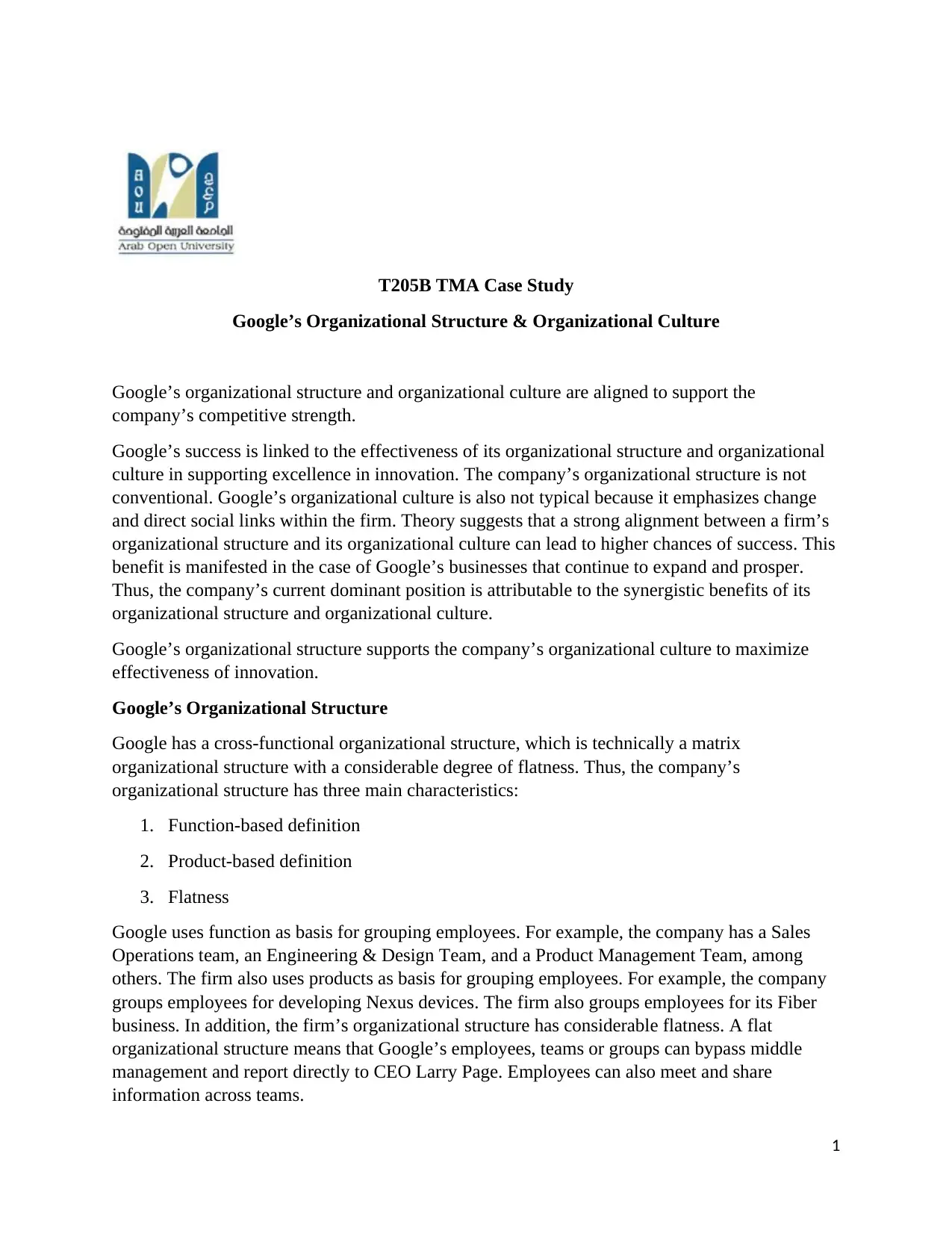
T205B TMA Case Study
Google’s Organizational Structure & Organizational Culture
Google’s organizational structure and organizational culture are aligned to support the
company’s competitive strength.
Google’s success is linked to the effectiveness of its organizational structure and organizational
culture in supporting excellence in innovation. The company’s organizational structure is not
conventional. Google’s organizational culture is also not typical because it emphasizes change
and direct social links within the firm. Theory suggests that a strong alignment between a firm’s
organizational structure and its organizational culture can lead to higher chances of success. This
benefit is manifested in the case of Google’s businesses that continue to expand and prosper.
Thus, the company’s current dominant position is attributable to the synergistic benefits of its
organizational structure and organizational culture.
Google’s organizational structure supports the company’s organizational culture to maximize
effectiveness of innovation.
Google’s Organizational Structure
Google has a cross-functional organizational structure, which is technically a matrix
organizational structure with a considerable degree of flatness. Thus, the company’s
organizational structure has three main characteristics:
1. Function-based definition
2. Product-based definition
3. Flatness
Google uses function as basis for grouping employees. For example, the company has a Sales
Operations team, an Engineering & Design Team, and a Product Management Team, among
others. The firm also uses products as basis for grouping employees. For example, the company
groups employees for developing Nexus devices. The firm also groups employees for its Fiber
business. In addition, the firm’s organizational structure has considerable flatness. A flat
organizational structure means that Google’s employees, teams or groups can bypass middle
management and report directly to CEO Larry Page. Employees can also meet and share
information across teams.
1
Google’s Organizational Structure & Organizational Culture
Google’s organizational structure and organizational culture are aligned to support the
company’s competitive strength.
Google’s success is linked to the effectiveness of its organizational structure and organizational
culture in supporting excellence in innovation. The company’s organizational structure is not
conventional. Google’s organizational culture is also not typical because it emphasizes change
and direct social links within the firm. Theory suggests that a strong alignment between a firm’s
organizational structure and its organizational culture can lead to higher chances of success. This
benefit is manifested in the case of Google’s businesses that continue to expand and prosper.
Thus, the company’s current dominant position is attributable to the synergistic benefits of its
organizational structure and organizational culture.
Google’s organizational structure supports the company’s organizational culture to maximize
effectiveness of innovation.
Google’s Organizational Structure
Google has a cross-functional organizational structure, which is technically a matrix
organizational structure with a considerable degree of flatness. Thus, the company’s
organizational structure has three main characteristics:
1. Function-based definition
2. Product-based definition
3. Flatness
Google uses function as basis for grouping employees. For example, the company has a Sales
Operations team, an Engineering & Design Team, and a Product Management Team, among
others. The firm also uses products as basis for grouping employees. For example, the company
groups employees for developing Nexus devices. The firm also groups employees for its Fiber
business. In addition, the firm’s organizational structure has considerable flatness. A flat
organizational structure means that Google’s employees, teams or groups can bypass middle
management and report directly to CEO Larry Page. Employees can also meet and share
information across teams.
1
Paraphrase This Document
Need a fresh take? Get an instant paraphrase of this document with our AI Paraphraser
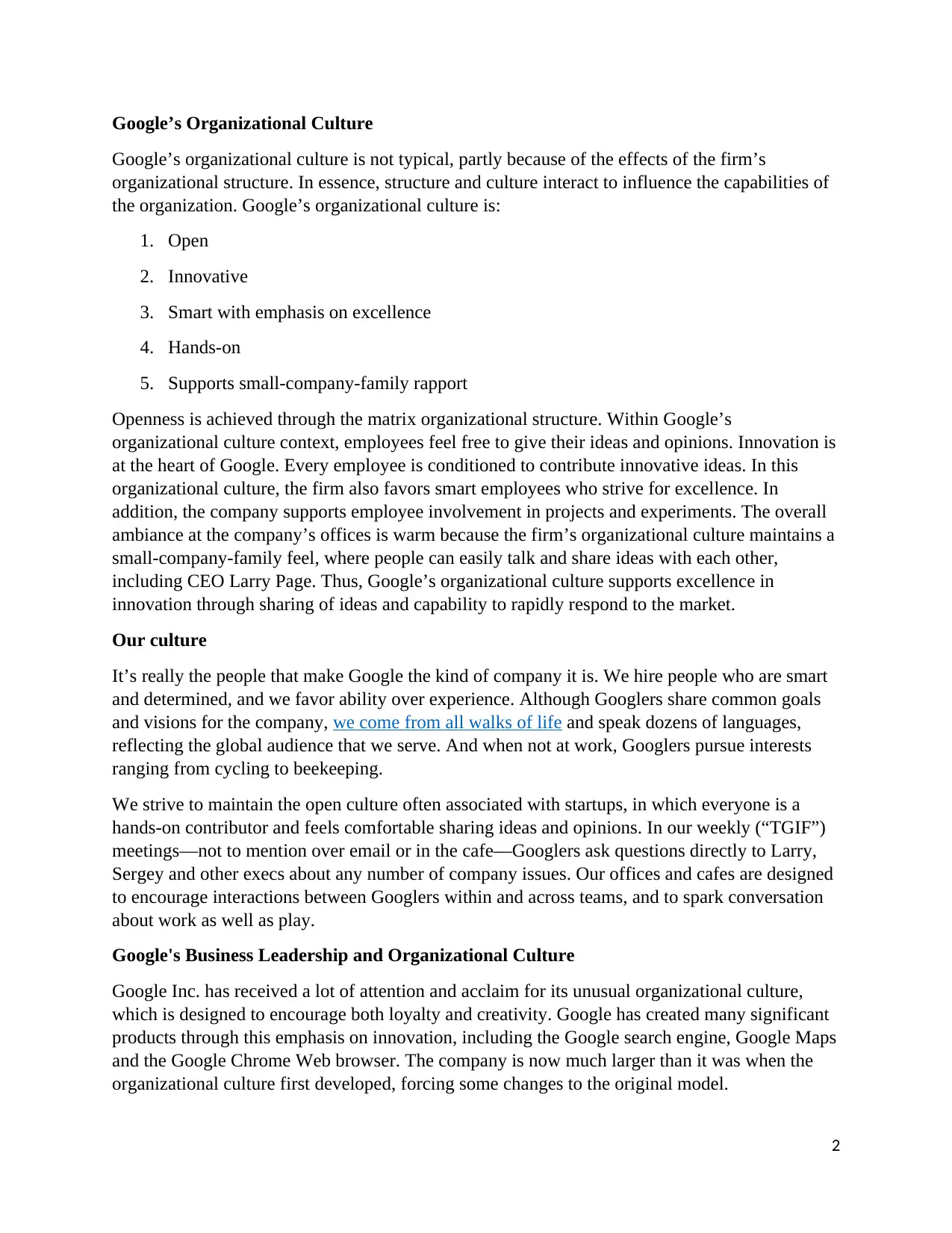
Google’s Organizational Culture
Google’s organizational culture is not typical, partly because of the effects of the firm’s
organizational structure. In essence, structure and culture interact to influence the capabilities of
the organization. Google’s organizational culture is:
1. Open
2. Innovative
3. Smart with emphasis on excellence
4. Hands-on
5. Supports small-company-family rapport
Openness is achieved through the matrix organizational structure. Within Google’s
organizational culture context, employees feel free to give their ideas and opinions. Innovation is
at the heart of Google. Every employee is conditioned to contribute innovative ideas. In this
organizational culture, the firm also favors smart employees who strive for excellence. In
addition, the company supports employee involvement in projects and experiments. The overall
ambiance at the company’s offices is warm because the firm’s organizational culture maintains a
small-company-family feel, where people can easily talk and share ideas with each other,
including CEO Larry Page. Thus, Google’s organizational culture supports excellence in
innovation through sharing of ideas and capability to rapidly respond to the market.
Our culture
It’s really the people that make Google the kind of company it is. We hire people who are smart
and determined, and we favor ability over experience. Although Googlers share common goals
and visions for the company, we come from all walks of life and speak dozens of languages,
reflecting the global audience that we serve. And when not at work, Googlers pursue interests
ranging from cycling to beekeeping.
We strive to maintain the open culture often associated with startups, in which everyone is a
hands-on contributor and feels comfortable sharing ideas and opinions. In our weekly (“TGIF”)
meetings—not to mention over email or in the cafe—Googlers ask questions directly to Larry,
Sergey and other execs about any number of company issues. Our offices and cafes are designed
to encourage interactions between Googlers within and across teams, and to spark conversation
about work as well as play.
Google's Business Leadership and Organizational Culture
Google Inc. has received a lot of attention and acclaim for its unusual organizational culture,
which is designed to encourage both loyalty and creativity. Google has created many significant
products through this emphasis on innovation, including the Google search engine, Google Maps
and the Google Chrome Web browser. The company is now much larger than it was when the
organizational culture first developed, forcing some changes to the original model.
2
Google’s organizational culture is not typical, partly because of the effects of the firm’s
organizational structure. In essence, structure and culture interact to influence the capabilities of
the organization. Google’s organizational culture is:
1. Open
2. Innovative
3. Smart with emphasis on excellence
4. Hands-on
5. Supports small-company-family rapport
Openness is achieved through the matrix organizational structure. Within Google’s
organizational culture context, employees feel free to give their ideas and opinions. Innovation is
at the heart of Google. Every employee is conditioned to contribute innovative ideas. In this
organizational culture, the firm also favors smart employees who strive for excellence. In
addition, the company supports employee involvement in projects and experiments. The overall
ambiance at the company’s offices is warm because the firm’s organizational culture maintains a
small-company-family feel, where people can easily talk and share ideas with each other,
including CEO Larry Page. Thus, Google’s organizational culture supports excellence in
innovation through sharing of ideas and capability to rapidly respond to the market.
Our culture
It’s really the people that make Google the kind of company it is. We hire people who are smart
and determined, and we favor ability over experience. Although Googlers share common goals
and visions for the company, we come from all walks of life and speak dozens of languages,
reflecting the global audience that we serve. And when not at work, Googlers pursue interests
ranging from cycling to beekeeping.
We strive to maintain the open culture often associated with startups, in which everyone is a
hands-on contributor and feels comfortable sharing ideas and opinions. In our weekly (“TGIF”)
meetings—not to mention over email or in the cafe—Googlers ask questions directly to Larry,
Sergey and other execs about any number of company issues. Our offices and cafes are designed
to encourage interactions between Googlers within and across teams, and to spark conversation
about work as well as play.
Google's Business Leadership and Organizational Culture
Google Inc. has received a lot of attention and acclaim for its unusual organizational culture,
which is designed to encourage both loyalty and creativity. Google has created many significant
products through this emphasis on innovation, including the Google search engine, Google Maps
and the Google Chrome Web browser. The company is now much larger than it was when the
organizational culture first developed, forcing some changes to the original model.
2
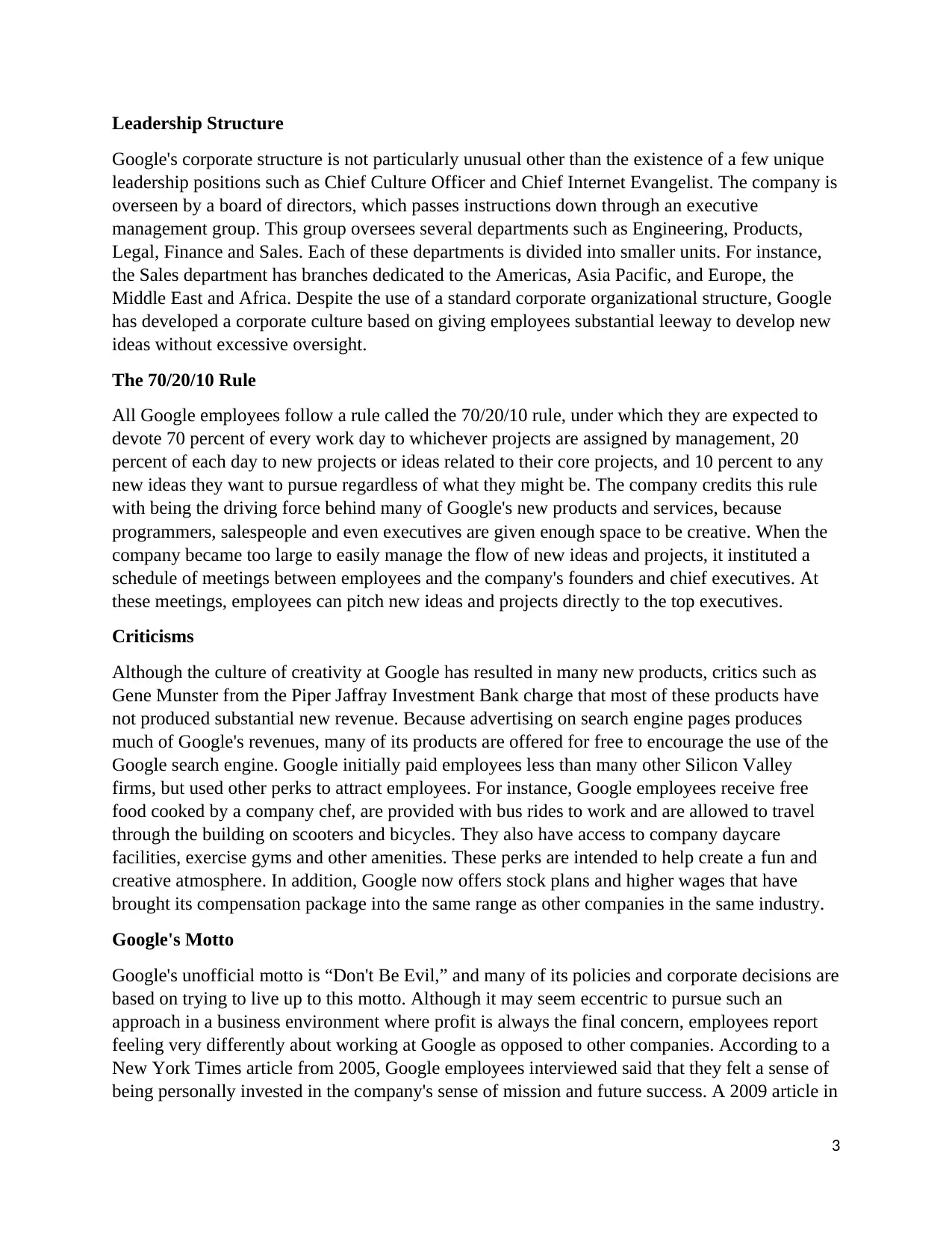
Leadership Structure
Google's corporate structure is not particularly unusual other than the existence of a few unique
leadership positions such as Chief Culture Officer and Chief Internet Evangelist. The company is
overseen by a board of directors, which passes instructions down through an executive
management group. This group oversees several departments such as Engineering, Products,
Legal, Finance and Sales. Each of these departments is divided into smaller units. For instance,
the Sales department has branches dedicated to the Americas, Asia Pacific, and Europe, the
Middle East and Africa. Despite the use of a standard corporate organizational structure, Google
has developed a corporate culture based on giving employees substantial leeway to develop new
ideas without excessive oversight.
The 70/20/10 Rule
All Google employees follow a rule called the 70/20/10 rule, under which they are expected to
devote 70 percent of every work day to whichever projects are assigned by management, 20
percent of each day to new projects or ideas related to their core projects, and 10 percent to any
new ideas they want to pursue regardless of what they might be. The company credits this rule
with being the driving force behind many of Google's new products and services, because
programmers, salespeople and even executives are given enough space to be creative. When the
company became too large to easily manage the flow of new ideas and projects, it instituted a
schedule of meetings between employees and the company's founders and chief executives. At
these meetings, employees can pitch new ideas and projects directly to the top executives.
Criticisms
Although the culture of creativity at Google has resulted in many new products, critics such as
Gene Munster from the Piper Jaffray Investment Bank charge that most of these products have
not produced substantial new revenue. Because advertising on search engine pages produces
much of Google's revenues, many of its products are offered for free to encourage the use of the
Google search engine. Google initially paid employees less than many other Silicon Valley
firms, but used other perks to attract employees. For instance, Google employees receive free
food cooked by a company chef, are provided with bus rides to work and are allowed to travel
through the building on scooters and bicycles. They also have access to company daycare
facilities, exercise gyms and other amenities. These perks are intended to help create a fun and
creative atmosphere. In addition, Google now offers stock plans and higher wages that have
brought its compensation package into the same range as other companies in the same industry.
Google's Motto
Google's unofficial motto is “Don't Be Evil,” and many of its policies and corporate decisions are
based on trying to live up to this motto. Although it may seem eccentric to pursue such an
approach in a business environment where profit is always the final concern, employees report
feeling very differently about working at Google as opposed to other companies. According to a
New York Times article from 2005, Google employees interviewed said that they felt a sense of
being personally invested in the company's sense of mission and future success. A 2009 article in
3
Google's corporate structure is not particularly unusual other than the existence of a few unique
leadership positions such as Chief Culture Officer and Chief Internet Evangelist. The company is
overseen by a board of directors, which passes instructions down through an executive
management group. This group oversees several departments such as Engineering, Products,
Legal, Finance and Sales. Each of these departments is divided into smaller units. For instance,
the Sales department has branches dedicated to the Americas, Asia Pacific, and Europe, the
Middle East and Africa. Despite the use of a standard corporate organizational structure, Google
has developed a corporate culture based on giving employees substantial leeway to develop new
ideas without excessive oversight.
The 70/20/10 Rule
All Google employees follow a rule called the 70/20/10 rule, under which they are expected to
devote 70 percent of every work day to whichever projects are assigned by management, 20
percent of each day to new projects or ideas related to their core projects, and 10 percent to any
new ideas they want to pursue regardless of what they might be. The company credits this rule
with being the driving force behind many of Google's new products and services, because
programmers, salespeople and even executives are given enough space to be creative. When the
company became too large to easily manage the flow of new ideas and projects, it instituted a
schedule of meetings between employees and the company's founders and chief executives. At
these meetings, employees can pitch new ideas and projects directly to the top executives.
Criticisms
Although the culture of creativity at Google has resulted in many new products, critics such as
Gene Munster from the Piper Jaffray Investment Bank charge that most of these products have
not produced substantial new revenue. Because advertising on search engine pages produces
much of Google's revenues, many of its products are offered for free to encourage the use of the
Google search engine. Google initially paid employees less than many other Silicon Valley
firms, but used other perks to attract employees. For instance, Google employees receive free
food cooked by a company chef, are provided with bus rides to work and are allowed to travel
through the building on scooters and bicycles. They also have access to company daycare
facilities, exercise gyms and other amenities. These perks are intended to help create a fun and
creative atmosphere. In addition, Google now offers stock plans and higher wages that have
brought its compensation package into the same range as other companies in the same industry.
Google's Motto
Google's unofficial motto is “Don't Be Evil,” and many of its policies and corporate decisions are
based on trying to live up to this motto. Although it may seem eccentric to pursue such an
approach in a business environment where profit is always the final concern, employees report
feeling very differently about working at Google as opposed to other companies. According to a
New York Times article from 2005, Google employees interviewed said that they felt a sense of
being personally invested in the company's sense of mission and future success. A 2009 article in
3
⊘ This is a preview!⊘
Do you want full access?
Subscribe today to unlock all pages.

Trusted by 1+ million students worldwide
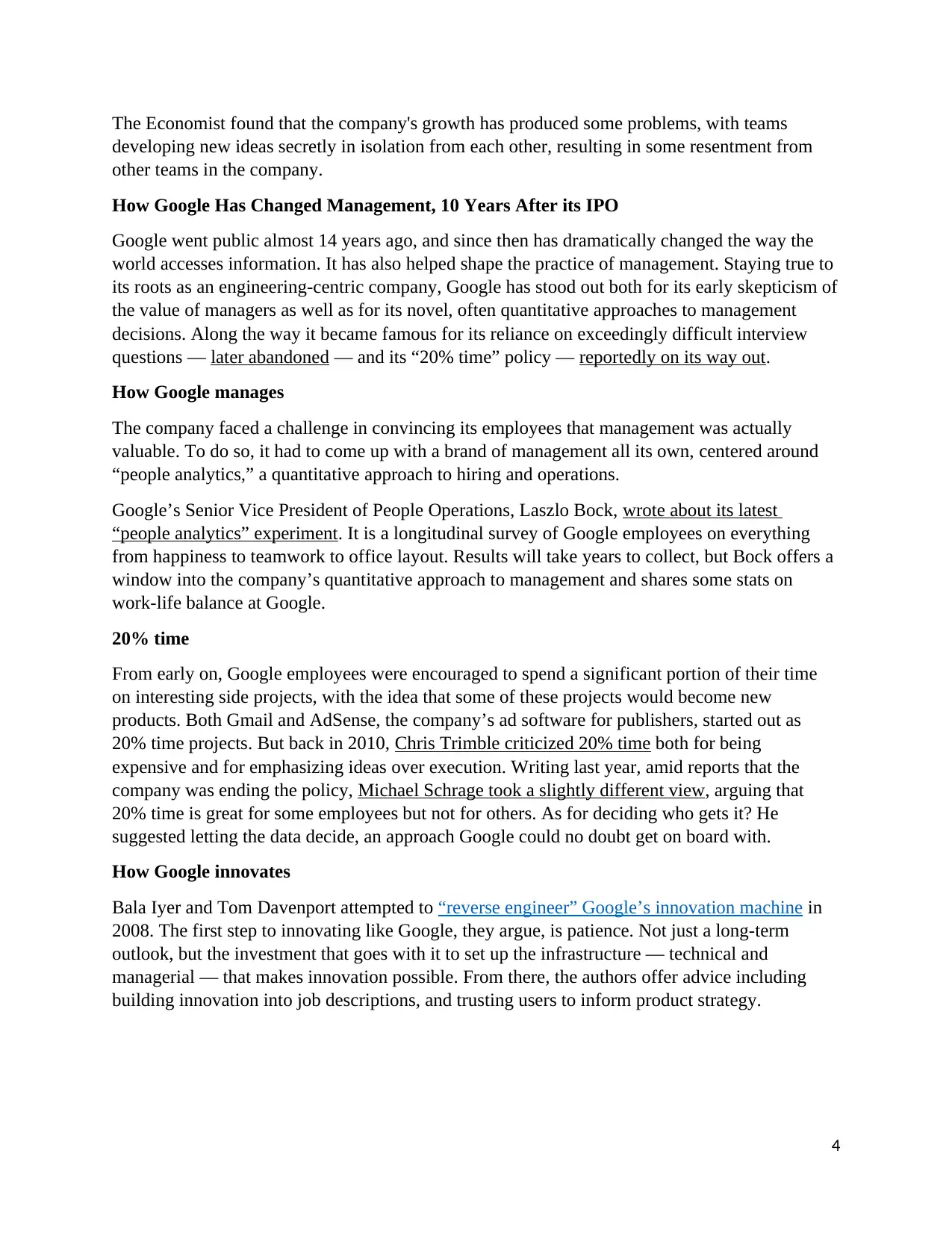
The Economist found that the company's growth has produced some problems, with teams
developing new ideas secretly in isolation from each other, resulting in some resentment from
other teams in the company.
How Google Has Changed Management, 10 Years After its IPO
Google went public almost 14 years ago, and since then has dramatically changed the way the
world accesses information. It has also helped shape the practice of management. Staying true to
its roots as an engineering-centric company, Google has stood out both for its early skepticism of
the value of managers as well as for its novel, often quantitative approaches to management
decisions. Along the way it became famous for its reliance on exceedingly difficult interview
questions — later abandoned — and its “20% time” policy — reportedly on its way out.
How Google manages
The company faced a challenge in convincing its employees that management was actually
valuable. To do so, it had to come up with a brand of management all its own, centered around
“people analytics,” a quantitative approach to hiring and operations.
Google’s Senior Vice President of People Operations, Laszlo Bock, wrote about its latest
“people analytics” experiment. It is a longitudinal survey of Google employees on everything
from happiness to teamwork to office layout. Results will take years to collect, but Bock offers a
window into the company’s quantitative approach to management and shares some stats on
work-life balance at Google.
20% time
From early on, Google employees were encouraged to spend a significant portion of their time
on interesting side projects, with the idea that some of these projects would become new
products. Both Gmail and AdSense, the company’s ad software for publishers, started out as
20% time projects. But back in 2010, Chris Trimble criticized 20% time both for being
expensive and for emphasizing ideas over execution. Writing last year, amid reports that the
company was ending the policy, Michael Schrage took a slightly different view, arguing that
20% time is great for some employees but not for others. As for deciding who gets it? He
suggested letting the data decide, an approach Google could no doubt get on board with.
How Google innovates
Bala Iyer and Tom Davenport attempted to “reverse engineer” Google’s innovation machine in
2008. The first step to innovating like Google, they argue, is patience. Not just a long-term
outlook, but the investment that goes with it to set up the infrastructure — technical and
managerial — that makes innovation possible. From there, the authors offer advice including
building innovation into job descriptions, and trusting users to inform product strategy.
4
developing new ideas secretly in isolation from each other, resulting in some resentment from
other teams in the company.
How Google Has Changed Management, 10 Years After its IPO
Google went public almost 14 years ago, and since then has dramatically changed the way the
world accesses information. It has also helped shape the practice of management. Staying true to
its roots as an engineering-centric company, Google has stood out both for its early skepticism of
the value of managers as well as for its novel, often quantitative approaches to management
decisions. Along the way it became famous for its reliance on exceedingly difficult interview
questions — later abandoned — and its “20% time” policy — reportedly on its way out.
How Google manages
The company faced a challenge in convincing its employees that management was actually
valuable. To do so, it had to come up with a brand of management all its own, centered around
“people analytics,” a quantitative approach to hiring and operations.
Google’s Senior Vice President of People Operations, Laszlo Bock, wrote about its latest
“people analytics” experiment. It is a longitudinal survey of Google employees on everything
from happiness to teamwork to office layout. Results will take years to collect, but Bock offers a
window into the company’s quantitative approach to management and shares some stats on
work-life balance at Google.
20% time
From early on, Google employees were encouraged to spend a significant portion of their time
on interesting side projects, with the idea that some of these projects would become new
products. Both Gmail and AdSense, the company’s ad software for publishers, started out as
20% time projects. But back in 2010, Chris Trimble criticized 20% time both for being
expensive and for emphasizing ideas over execution. Writing last year, amid reports that the
company was ending the policy, Michael Schrage took a slightly different view, arguing that
20% time is great for some employees but not for others. As for deciding who gets it? He
suggested letting the data decide, an approach Google could no doubt get on board with.
How Google innovates
Bala Iyer and Tom Davenport attempted to “reverse engineer” Google’s innovation machine in
2008. The first step to innovating like Google, they argue, is patience. Not just a long-term
outlook, but the investment that goes with it to set up the infrastructure — technical and
managerial — that makes innovation possible. From there, the authors offer advice including
building innovation into job descriptions, and trusting users to inform product strategy.
4
Paraphrase This Document
Need a fresh take? Get an instant paraphrase of this document with our AI Paraphraser
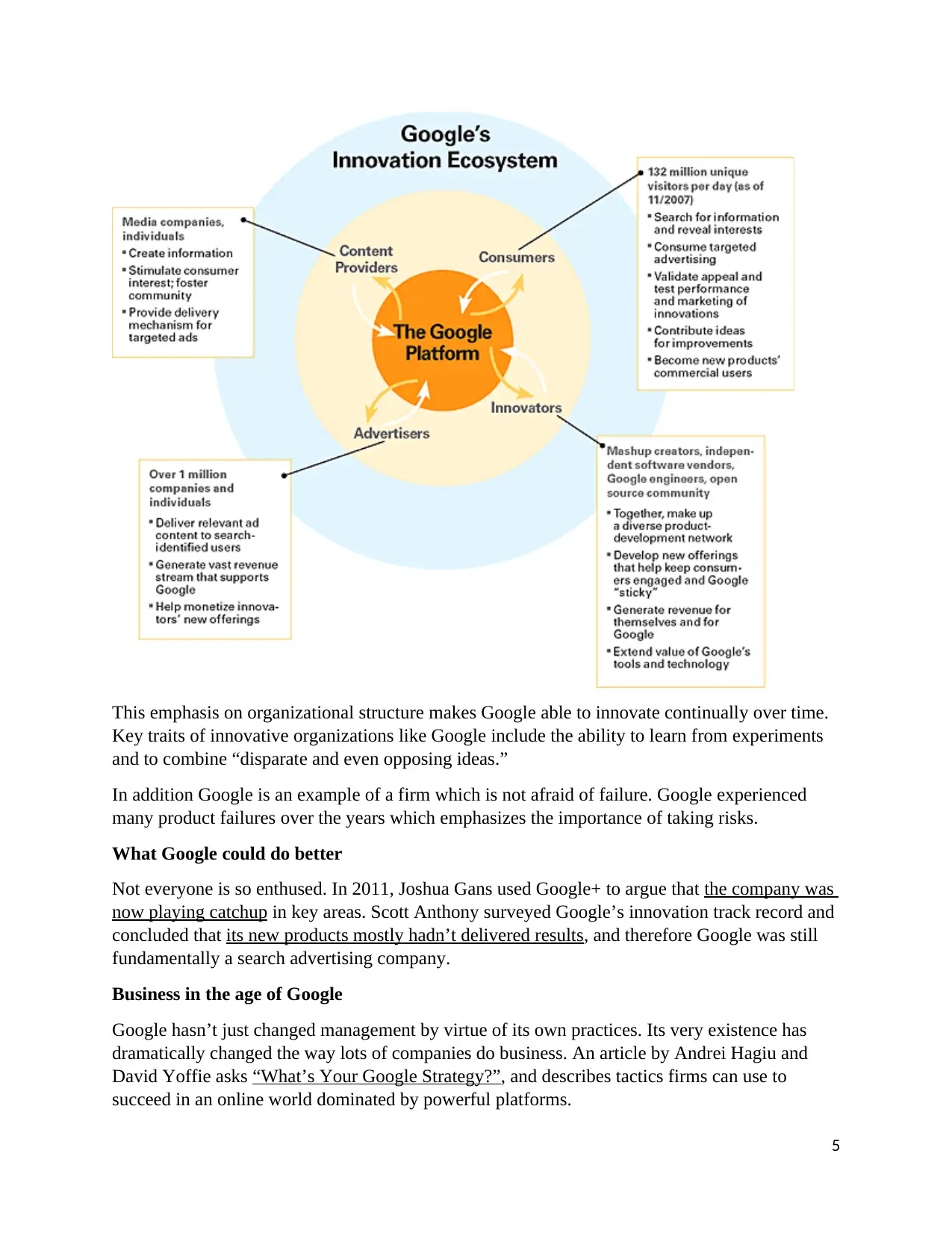
This emphasis on organizational structure makes Google able to innovate continually over time.
Key traits of innovative organizations like Google include the ability to learn from experiments
and to combine “disparate and even opposing ideas.”
In addition Google is an example of a firm which is not afraid of failure. Google experienced
many product failures over the years which emphasizes the importance of taking risks.
What Google could do better
Not everyone is so enthused. In 2011, Joshua Gans used Google+ to argue that the company was
now playing catchup in key areas. Scott Anthony surveyed Google’s innovation track record and
concluded that its new products mostly hadn’t delivered results, and therefore Google was still
fundamentally a search advertising company.
Business in the age of Google
Google hasn’t just changed management by virtue of its own practices. Its very existence has
dramatically changed the way lots of companies do business. An article by Andrei Hagiu and
David Yoffie asks “What’s Your Google Strategy?”, and describes tactics firms can use to
succeed in an online world dominated by powerful platforms.
5
Key traits of innovative organizations like Google include the ability to learn from experiments
and to combine “disparate and even opposing ideas.”
In addition Google is an example of a firm which is not afraid of failure. Google experienced
many product failures over the years which emphasizes the importance of taking risks.
What Google could do better
Not everyone is so enthused. In 2011, Joshua Gans used Google+ to argue that the company was
now playing catchup in key areas. Scott Anthony surveyed Google’s innovation track record and
concluded that its new products mostly hadn’t delivered results, and therefore Google was still
fundamentally a search advertising company.
Business in the age of Google
Google hasn’t just changed management by virtue of its own practices. Its very existence has
dramatically changed the way lots of companies do business. An article by Andrei Hagiu and
David Yoffie asks “What’s Your Google Strategy?”, and describes tactics firms can use to
succeed in an online world dominated by powerful platforms.
5
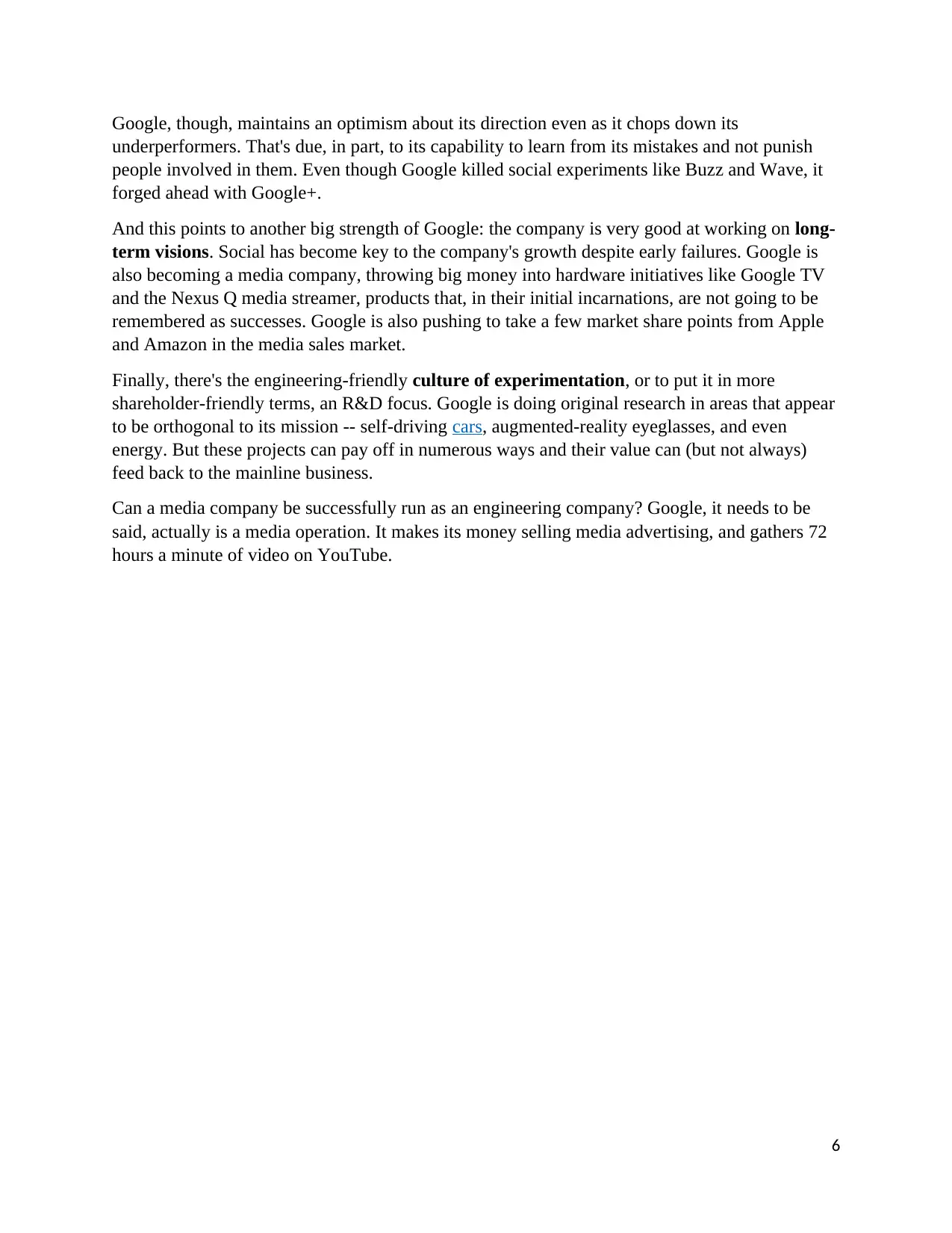
Google, though, maintains an optimism about its direction even as it chops down its
underperformers. That's due, in part, to its capability to learn from its mistakes and not punish
people involved in them. Even though Google killed social experiments like Buzz and Wave, it
forged ahead with Google+.
And this points to another big strength of Google: the company is very good at working on long-
term visions. Social has become key to the company's growth despite early failures. Google is
also becoming a media company, throwing big money into hardware initiatives like Google TV
and the Nexus Q media streamer, products that, in their initial incarnations, are not going to be
remembered as successes. Google is also pushing to take a few market share points from Apple
and Amazon in the media sales market.
Finally, there's the engineering-friendly culture of experimentation, or to put it in more
shareholder-friendly terms, an R&D focus. Google is doing original research in areas that appear
to be orthogonal to its mission -- self-driving cars, augmented-reality eyeglasses, and even
energy. But these projects can pay off in numerous ways and their value can (but not always)
feed back to the mainline business.
Can a media company be successfully run as an engineering company? Google, it needs to be
said, actually is a media operation. It makes its money selling media advertising, and gathers 72
hours a minute of video on YouTube.
6
underperformers. That's due, in part, to its capability to learn from its mistakes and not punish
people involved in them. Even though Google killed social experiments like Buzz and Wave, it
forged ahead with Google+.
And this points to another big strength of Google: the company is very good at working on long-
term visions. Social has become key to the company's growth despite early failures. Google is
also becoming a media company, throwing big money into hardware initiatives like Google TV
and the Nexus Q media streamer, products that, in their initial incarnations, are not going to be
remembered as successes. Google is also pushing to take a few market share points from Apple
and Amazon in the media sales market.
Finally, there's the engineering-friendly culture of experimentation, or to put it in more
shareholder-friendly terms, an R&D focus. Google is doing original research in areas that appear
to be orthogonal to its mission -- self-driving cars, augmented-reality eyeglasses, and even
energy. But these projects can pay off in numerous ways and their value can (but not always)
feed back to the mainline business.
Can a media company be successfully run as an engineering company? Google, it needs to be
said, actually is a media operation. It makes its money selling media advertising, and gathers 72
hours a minute of video on YouTube.
6
⊘ This is a preview!⊘
Do you want full access?
Subscribe today to unlock all pages.

Trusted by 1+ million students worldwide
1 out of 6
Related Documents
Your All-in-One AI-Powered Toolkit for Academic Success.
+13062052269
info@desklib.com
Available 24*7 on WhatsApp / Email
![[object Object]](/_next/static/media/star-bottom.7253800d.svg)
Unlock your academic potential
Copyright © 2020–2025 A2Z Services. All Rights Reserved. Developed and managed by ZUCOL.




